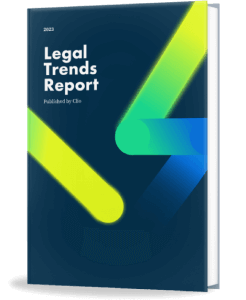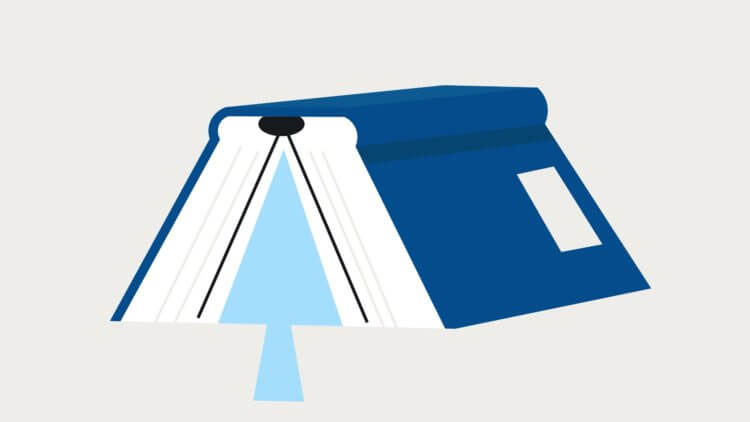Given the events of the past year, preparing for success in 2023 can feel overwhelming for lawyers. Thankfully, key lawyer statistics can make preparing for 2023 a lot easier. From the current number of lawyers in the US to how (and how much) attorneys across the country are billing, knowing up-to-date lawyer facts and statistics can give you a clearer picture of where you stand, and which direction you may want to head.
Whether you’re currently contemplating law school, starting your career as a new lawyer, or trying to guide your business in the right direction as a seasoned legal professional, we’ve compiled the following statistics about lawyers to illuminate where the industry stands today—and help you make key decisions for success this year and beyond.
And of course, for the latest statistics, always be sure to download the latest Legal Trends Report!
1. There are 1.3 million lawyers in the US
Exactly how many lawyers are there in the US? According to the American Bar Association’s 2020 ABA Profile of the Legal Profession, there are currently about 1.3 million lawyers in the US. Specifically, for every 1,000 residents in the US, there are only four lawyers. Knowing the status and size of your industry helps you understand your playing field in the legal marketplace.
2. The states with the most lawyers are New York, Maryland, and Massachusetts
Where are the majority of those lawyers located? The ABA’s Profile of the Legal Profession reports that New York (with 9.5 lawyers per 1,000 residents), Maryland (with 6.7 lawyers per 1,000 residents), and Massachusetts (with 6.2 lawyers per 1,000 residents) were the states with the most lawyers per residents based on 2019 population data.
If you practice in these states, you’ll know that competition is tough. Making sure you have a strong law firm brand is one of the key ways you can stand out from your competitors. And if you don’t practice in these states, you can look into easing the access to justice gap and accessing more of the market in your area.
You may like these posts
3. 37% of lawyers are female and 86% are white
The American Bar Association’s 10-year look at lawyer demographic trends shows some movement towards equality (in 2010, only 31% of lawyers were female and 89% of attorneys were white), but the statistics about lawyers show that the profession still has work to do.
What does this lawyer statistic mean for your law firm? As Lawline highlights, diversity has many benefits, including increasing innovation at your firm and bringing more diverse clients. To improve law firm diversity and inclusion with your firm’s brand, Katy Goshtasbi underscores a powerful four-step process to reimagining your law firm brand with diversity and EQ in mind.
4. Women outnumber men in law schools

Looking again at the ABA’s Profile of the Legal Profession, the number of female law students is rising: Of the 112,000 law school students in the US, 53% are women (and, at four law schools, women outnumber men two-to-one).
Comparing this to statistic #3 above, there seems to be a disconnect between the number of women in law schools, and the number of women moving on to becoming legal practitioners. The Council on Foreign Relations (CFR) indicates that in the US, the top barriers women face in the workplace include getting a job and protecting women from violence. It is worth examining how your law firm can foster a better environment for hiring more women and improving diversity.
5. Jobs for lawyers are expected to grow 4% in the next decade
The job outlook for lawyers—according to the US Bureau of Labor Statistics’ Occupational Outlook Handbook—is overall positive, with a 4% projected growth rate for lawyers between 2019 and 2029, which is in line with the projected average for all jobs.
For more lawyer statistics, check out our blog: Seven legal marketing statistics every attorney should know.
6. In 2020, the median pay for a lawyer was $126,930
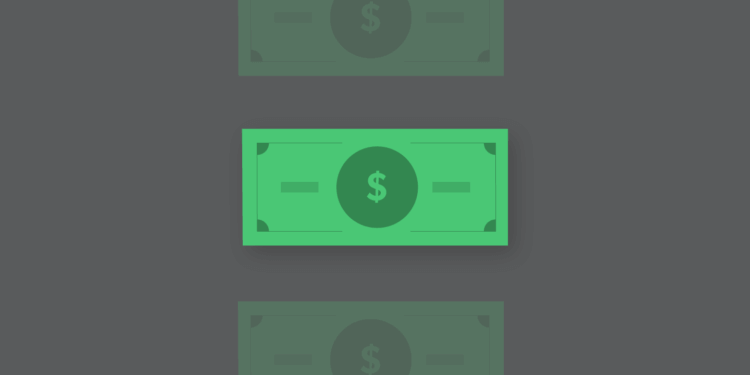
As of May of 2020, the US Bureau of Labor Statistics Occupational Outlook Handbook reports that the median annual wage for lawyers was $126,930. While it varies by region and practice area, knowing the lawyer statistics for average pay can help you assess where you stand when it comes to income.
7. The average hourly billable rate for lawyers was $300 per hour in January 2021
Billable rates for lawyers are rising. As reported in Clio’s 2021 Legal Trends Report, the average hourly billable rate for lawyers has been on the upswing in recent years and hit $300 by the start of 2021.
8. The highest average hourly billable rate by state is $411 in DC
When it comes to hourly rates by state for lawyers, the 2021 Legal Trends Report shows that lawyers in DC charge the highest hourly rate, followed by $372 per hour by lawyers in New York.
9. The lowest average hourly billable rate by state is $163 in West Virginia
At the other end of the spectrum, the lowest average hourly billable rate for lawyers in the US is in West Virginia, according to the 2021 Legal Trends Report. The report also looks at rates adjusted for cost of living, which is worth looking at if you’re deciding where to practice.
10. The highest average hourly billing rate by practice area was a tie—$362 for bankruptcy and intellectual property
Different practice areas charge vastly different rates, as well. The 2021 Legal Trends Report found that bankruptcy and intellectual property were tied for the practice areas with the highest average hourly billing rate.
11. The lowest average hourly billing rate by practice area was $91 for juvenile
The practice area with the lowest average hourly billing rate for lawyers? Juvenile law, according to Clio’s 2021 Legal Trends Report.
12. The average lawyer billed just 2.5 hours (31%) of an 8-hour day
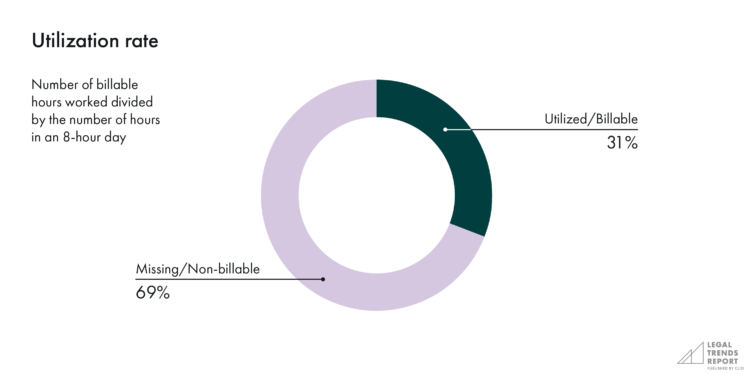
One of the biggest challenges that law firms deal with appears to be the low utilization rates we see on an industry-wide basis. Utilization is the measure of how much of an 8-hour workday is devoted to billable work at a law firm, measured on a per-lawyer basis. As shown in the 2021 Legal Trends Report, in 2020, the average lawyer billed just 2.5 hours (31%) of an 8-hour day, indicating that many lawyers either don’t have enough clients to fill their day or that they struggle with inefficiencies in their firms that distract from billable work. Low utilization rates might indicate a need for more clients or improved efficiency.
Use automation to increase efficiency at your law firm: Watch our on-demand webinar to learn more.
13. Lawyers don’t collect on 12% of the hours they bill to clients
The 2021 Legal Trends Report also notes a collection rate (that is, the percentage of hours collected divided by the number of hours invoiced) of 89%—which means that lawyers are not paid for 11% of hours that they’ve worked and billed to clients. Finding a way to increase this rate could mean more potential revenue coming in for the hours already worked.
14. 85% of legal professionals were using some form of software to manage their firms
The 2021 Legal Trends Report also found the vast majority of lawyers—95% or higher in most cases— plan to continue to use these technologies beyond the pandemic, which is a clear indication that this technology adoption has become the norm for most firms
15. 81% of consumers would prefer to pay via payment plans
Another key statistic about lawyers from the 2021 Legal Trends Report is that today’s consumers want convenience and options when it comes to paying.
The 2021 Legal Trends Report also noted in 2020, firms that were using online payments, client portals, and client intake and CRM software saw 6% year-over-year growth during some of the most intense periods of the pandemic—and collected nearly 40% more revenue per lawyer compared to firms not using these technologies. This data reveals an opportunity for lawyer success in the years to come. If the majority of consumers want to pay their legal fees via payment plan and electronically, but fewer lawyers are set up to offer them, offering legal payment plans could make your firm stand out to potential clients.
16. 40% of consumers would never hire a lawyer who didn’t take debit or credit cards
Reinforcing these lawyer statistics, as Clio’s 2021 Legal Trends Report noted, the ability to make payments electronically is non-negotiable for many clients. When asked about their preferred method of payment, 66% of clients said online payments was their top choice, followed by automated payments (61%), and payments via mobile app (61%).
17. Growing firms are 37% more likely to use online payments
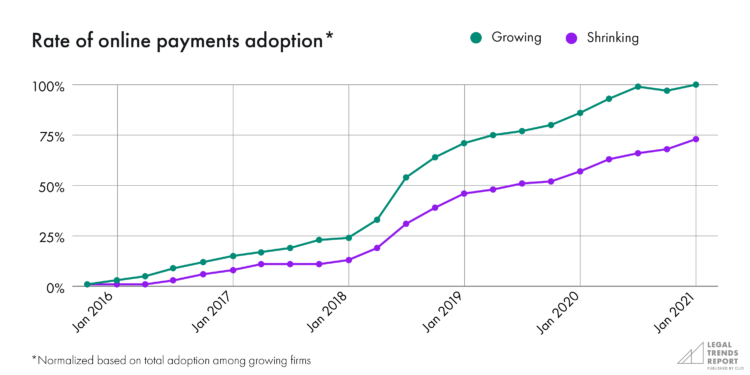
As shown in the 2021 Legal Trends Report, when analyzing the adoption trends among both growing and shrinking cohorts, we see that growing firms have adopted online payments at a much quicker rate. This finding, along with other data in the report, reveals that while offering online payments may have been a competitive advantage in the past, it’s now a standard feature legal clients expect.
18. 59% of lawyers are using web-based software solutions
Cloud computing continues to be significant for business success, with the majority of lawyers using online solutions—59% of participants in the 2020 ABA Legal Technology Survey Report said that they used web-based software services or solutions.
Make your mark online in minutes with our simple legal website builder
Easy-to-edit templates, no coding required—get your website up and running in the time it takes to make a cup of coffee.
19. 62% of law firms budget for technology
This is a slight increase from 2019, where only 60% of firms indicated to the ABA Legal Technology Survey Report that they budgeted for tech. We expect this number to increase significantly in years to come.
20. 89% of legal professionals believe court systems can be improved with better access to technology
One benefit of the sudden need to rethink meeting in person is that it’s shown that technology could be used to improve court processes. As the majority of legal professionals indicate in the 2020 Legal Trends Report, using more technology could lead to opportunities for positive changes in the courts. Moving processes like case management and court files to electronic systems could increase efficiency and affordability for the people they are meant to serve—and ultimately help improve access to justice.
21. 79% of clients want the option to work remotely with their lawyer
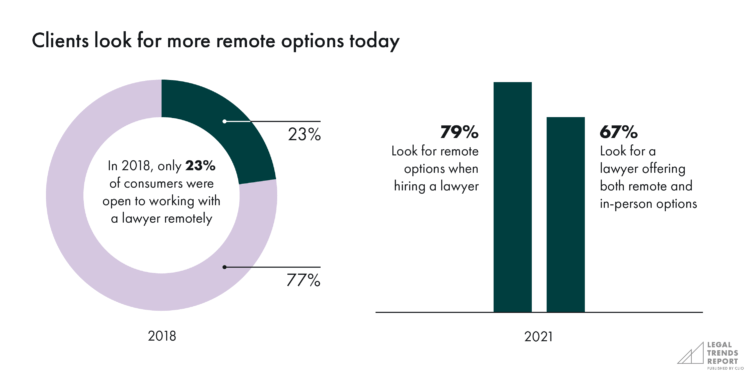
The 2021 Legal Trends Report found that 79% of survey respondents saw the option to work remotely with a lawyer as an important factor when hiring a lawyer. Comparing this to 2018 insights—only 23% of consumers were open to the idea of working with a lawyer remotely—we can see the exponential growth in demand for remote working options. Similar to the online payments insights, the story is the same. Offering remote services might have set you apart from other firms three years ago, but now shifting consumer demands are standardizing Zoom consultations.
22. Firms using multiple technologies collected 40% more revenue per lawyer
Using some technology can be advantageous to lawyers. But using multiple technologies is shown to be better when it comes to drawing in revenue. Clio’s 2021 Legal Trends Report looked at the use of three key cloud technologies for lawyers: online payments, client portals, and client intake and CRM software. The report’s analysis shows that, as of 2020, firms that were using these technologies experienced 6% year-over-year growth during some of the most intense periods of the pandemic. And what was most compelling—these same tech-centric firms collected nearly 40% more revenue per lawyer compared to firms not using these technologies.
23. 79% of consumers saw the option to work remotely with a lawyer as an important factor
With COVID-19 moving many aspects of life online, more clients are willing—and in many cases, prefer—to conduct legal meetings virtually. The 2021 Legal Trends Report shows that 79% of consumers saw the option to work remotely with a lawyer as an important factor that would have a positive influence on their decision to hire that lawyer. When it comes to the initial meeting or consultation, the most stand-out takeaway from survey data in the 2021 Legal Trends Report is that video conferencing ranked very highly among consumers. While in-person (76%) is the most commonly preferred, with phone (70%) the next most common, video conferencing (58%) is the next most viable option among clients, demonstrating a radical shift compared with how low this preference appeared in our 2018 data.
24. Reviews and referrals are sought by 82% and 81% of consumers
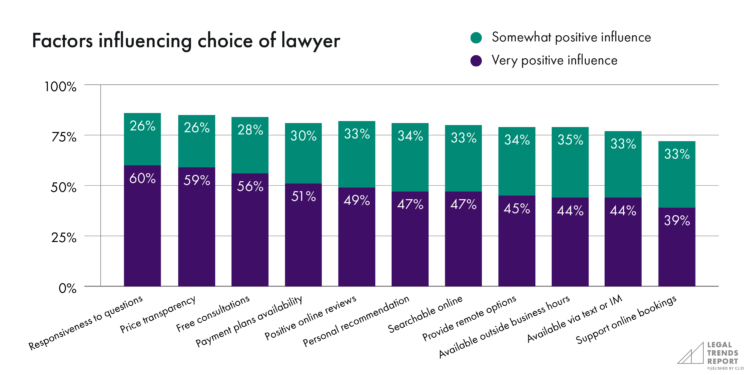
It should come as no surprise to hear that technology can influence a firm’s ability to deliver across other aspects of the client experience. When it comes to reviews and referrals—sought by 82% and 81% of consumers, 2021 Legal Trends Report—will also be influenced by the positive experiences that firms provide. A positive experience could be influenced by one of the factors above.
25. 45% of legal professionals believe technology can help create a more equitable justice system
Technology adoption isn’t always a cut-and-dry topic, but the 2020 Legal Trends Report shows that legal professionals see the opportunity to use tech to promote more equality in the justice system. This is an inspiring and encouraging statistic for the future of the legal industry.
26. Tech solutions earned solo law firms $50,000 more in revenue
As the 2021 Legal Trends for Solo Law Firms shows, solo law firms using electronic payments, client portals, and client intake and CRM solutions collected $52,507 more revenue than other solo firms. Interestingly, this same demographic of solo attorneys also out-earned firms with more lawyers using these technologies—by $14,885. This revenue advantage (nearly $15,000 per year) represents a massive sum for any solo law firm or any law firm on a per-lawyer basis.
For the latest law firm statistics, be sure to download the latest Legal Trends Report, so your firm can be set up for success long-term.
Do lawyers use statistics?
All lawyers can benefit from reviewing certain statistics. Statistical data can help lawyers forecast and prepare for the future. Specifically, marketing and business statistics can complement your firm’s growth strategy by helping provide a fuller picture of the legal landscape.
We published this blog post in December 2020. Last updated: .
Categorized in: Business, Technology



